
January 17, 2000
Environmental scientist Brent Haddad enters California's 'water wars'
By Jennifer McNulty
It's tough for environmental scientist Brent Haddad to address California water policy
issues in the wake of the movie Chinatown and the book Cadillac Desert.
Even Californians who know little about the state's pending water crisis know enough
history to fear that thirsty cities and greedy developers will do anything to get
their hands on water, even destroy prime agricultural land.
 |
Virtually all water in California is already spoken for by farms, cities, and environmental interests. With no new sources on the horizon, the challenge becomes one of reallocation. Agriculture consumes the lion's share of developed water--about 85 percent--and agricultural irrigation districts typically have direct water rights or contracts with the state and federal government.
The need for an effective allocation system is clear: Cities are growing, and they have the demographic, economic, and political power--as well as the financial clout--to get more water. Some cities are willing to pay $10,000 for a permanent acre foot of water, which is enough to supply two to four houses a year, said Haddad. There are very few rules governing where cities can buy land, and without an effective water reallocation system, Haddad predicts that cities will get into the business of "water ranching," or buying up farmland. That occurred in the Owens Valley area of southern California, a saga that is depicted in both Cadillac Desert and Chinatown.
"Because water is so critical to the well-being of the region in which it is being used, you're bound to hurt somebody if you transfer water," said Haddad. "You have to compensate the losers, in this case farmers and rural communities, which is why the institutional design is so important."
For two decades, policy makers and academics have been talking about using a market system to allocate water, but they have been unable to create an effective design, said Haddad, who has extensive professional experience with designing markets for natural resource management and environmental protection.
Haddad's proposal would create:
- A system of smaller regional markets that would operate under statewide transfer
limits set by legislators.
- Specific review procedures for proposed transfers that would be slightly broader
than existing environmental impact reviews and would include consideration of the
economic and social interests of the region that would be losing water.
- Incentives to encourage urban regions to develop a long-term commitment to the
well-being of the region from which they are taking water.
- Requirements that farmers demonstrate at the end of a multiyear lease-transfer their ability to put the water to its original agricultural use. Farmers would have to meet the requirement in order to continue to hold the rights to the water; such a rule would prevent farmers from becoming water dealers, said Haddad.
"Everybody loses a little, but nobody loses everything, and the state could
gain an effective water reallocation system," said Haddad, whose book includes
detailed case studies of the three major historical water transfers in California:
the Metropolitan Water District of Southern California's attempts to acquire water
from the Palo Verde Irrigation District and the Imperial Irrigation District, and
the Castaic Lake Water District's efforts to acquire water from the Devil's Den Water
District.
Under Haddad's proposal, the concepts of "feasibility" and "appropriateness"
would be weighed as heavily as the traditional economic notion of "efficiency"
when evaluating proposed water transfers.
"Some proposals have been too cumbersome, or too politically unrealistic, or
too economically problematic to ever have a hope of accomplishing the end goal, so
I'm saying that projects have to be feasible," explained Haddad. "By appropriateness,
I'm stressing that these processes need to be consistent with the basic values governing
California society and that transfer proposals should be compared in that light,
with support going to the ones that are most in line with the state's values."
Such concepts represent a significant departure from traditional market design and
might be dismissed as "ivory tower optimism," concedes Haddad, whose accomplishments
prior to joining academia suggest otherwise. Haddad was one of the nation's first
emissions traders under air pollution regulations, and as a financial adviser he
held a number of securities licenses. As a scholar, Haddad specializes in environmental
policy, investigating the use of market-based methods to manage natural resources.
As a well-established tool to manage air and water pollution, such strategies involve
the creation of property rights that allow companies and individuals to trade their
shares.
Markets have the potential to help solve California's water problems, asserts Haddad.
The scope of urban need is not nearly as large as many imagine, said Haddad, suggesting
that history--with the aid of popular culture and special interests--has distorted
the picture.
"Agriculture is by far the biggest water user in California, but even if we
doubled urban water use to 30 percent of the supply, which is way more than cities
would need, agriculture would only drop to 70 percent," said Haddad. "It's
not like we're going to lose farming in California, even in the worst case scenario."
That margin allows for creativity, he added.
"Economists tout the efficiency of open markets, but in this case we don't have
to have the most efficient system to satisfy our policy goals," said Haddad.
"We can afford to lose some transfers that make sense in theory in order to
get transfers that work in practice."
If water ranching is discouraged and no new allocation system is put in place, Californians
will have three options, according to Haddad: conservation, which is already taking
place; water recycling, which many find unpalatable; and desalination of seawater,
which is prohibitively expensive.
"Farmers are worried about losing their water rights, but it's inevitable that
they are going to lose some water," said Haddad. "Here's a way to do it
while preserving as much of the agricultural way of life as possible."